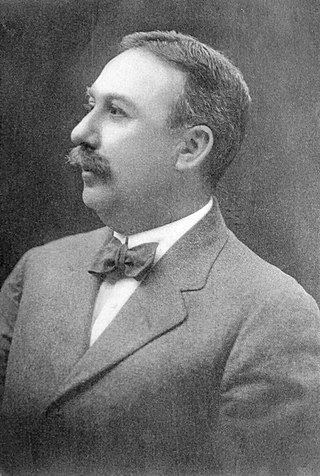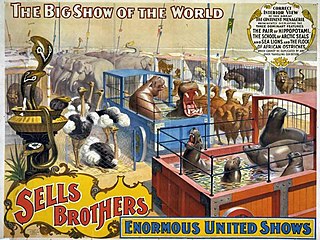Related Research Articles

The Great Train Robbery is a 1903 American silent film made by Edwin S. Porter for the Edison Manufacturing Company. It follows a gang of outlaws who hold up and rob a steam locomotive at a station in the American West, flee across mountainous terrain, and are finally defeated by a posse of locals. The short film draws on many sources, including a robust existing tradition of Western films, recent European innovations in film technique, the play of the same name by Scott Marble, the popularity of train-themed films, and possibly real-life incidents involving outlaws such as Butch Cassidy.
The year 1903 in film involved many significant events in cinema.
The year 1901 in film involved some significant events.

Topsy was a female Asian elephant who was electrocuted at Coney Island, New York, in January 1903. Born in Southeast Asia around 1875, Topsy was secretly brought into the United States soon thereafter and added to the herd of performing elephants at the Forepaugh Circus, who fraudulently advertised her as the first elephant born in the United States. During her 25 years at Forepaugh, Topsy gained a reputation as a "bad" elephant and, after killing a spectator in 1902, was sold to Coney Island's Sea Lion Park. Sea Lion was leased out at the end of the 1902 season and during the construction of the park that took its place, Luna Park, Topsy was used in publicity stunts and also involved in several well-publicized incidents, attributed to the actions of either her drunken handler or the park's new publicity-hungry owners, Frederic Thompson and Elmer "Skip" Dundy.

Edwin Stanton Porter was an American film pioneer, most famous as a producer, director, studio manager and cinematographer with the Edison Manufacturing Company and the Famous Players Film Company. Of over 250 films created by Porter, his most important include What Happened on Twenty-third Street, New York City (1901), Jack and the Beanstalk (1902), Life of an American Fireman (1903), The Great Train Robbery (1903), The European Rest Cure (1904), The Kleptomaniac (1905), Life of a Cowboy (1906), Rescued from an Eagle's Nest (1908), and The Prisoner of Zenda (1913).

Edison Studios was an American film production organization, owned by companies controlled by inventor and entrepreneur, Thomas Edison. The studio made close to 1,200 films, as part of the Edison Manufacturing Company (1894–1911) and then Thomas A. Edison, Inc. (1911–1918), until the studio's closing in 1918. Of that number, 54 were feature length, and the remainder were shorts. All of the company's films have fallen into the public domain because they were released before 1928.

The Hagenbeck–Wallace Circus was a circus that traveled across America in the early part of the 20th century. At its peak, it was the second-largest circus in America next to Ringling Brothers and Barnum and Bailey Circus. It was based in Peru, Indiana.

Stuart LeRoy Thayer was a historian of American circuses.

Electrocuting an Elephant is a 1903 American, short, black-and-white, silent documentary film of the killing of the elephant Topsy by electrocution at a Coney Island amusement park. It was produced by the Edison film company and is believed to have been shot by Edwin S. Porter or Jacob Blair Smith.

Another Job for the Undertaker is a 1901 silent comic trick film made at Edison's recently opened studio at 41 East 21st Street in Manhattan. It was photographed by Edwin S. Porter and co-directed by Porter and George S. Fleming. The two-shot film was copyrighted on May 15, 1901 and is approximately two minutes in length. It lacks a head title, which would have been supplied by projecting a separate lantern slide before screening the film.
Frederick S. Armitage was an early American motion picture cinematographer and director, working primarily for the American Mutoscope and Biograph Company. Often identified as "F.S. Armitage" in AM&B paperwork, Armitage had a hand in creating more than 400 often very short subjects for AM&B in the days where its films were made as much for the hand-crank operated Mutoscope device as for projection. Several of Armitage's subjects stand out from the company's regular routine of actualities and comic skits in their innovative use of camerawork, superimpositions, time-lapse photography and other effects then new to the art of film-making.

The Circus Building is an exhibit building at Shelburne Museum in Shelburne, Vermont. It houses a collection of circus posters, Gustav A. Dentzel Carousel animals, and elaborately carved miniature circuses, including those by Roy Arnold and Edgar Kirk.

Sells Brothers Circus was a circus founded by Ephraim, William, Lewis and Peter Sells in Columbus, Ohio, United States.

Water for Elephants is a 2011 American romantic drama film directed by Francis Lawrence from a screenplay by Richard LaGravenese, based on the 2006 novel of the same name by Sara Gruen. The film stars Reese Witherspoon, Robert Pattinson, Christoph Waltz, and Hal Holbrook.

The Countryman and the Cinematograph is a 1901 British short silent comedy film, directed by Robert W. Paul, featuring a stereotypical yokel reacting to films projected onto a screen. The film "is one of the earliest known examples of a film within a film", where, according to Michael Brooke of BFI Screenonline, "the audience reaction to that film is as important a part of the drama as the content of the film itself".

Execution of Czolgosz with Panorama of Auburn Prison is a 1901 silent film produced by the Edison Studios arms of Edison Manufacturing Company. The film is a dramatic reenactment of the execution of Leon Czolgosz by electric chair at Auburn Correctional Facility following his 1901 conviction for the assassination of William McKinley. It is considered an important film in the history of cinema.
The Boston Tea Party is a 1908 silent film directed by Edwin S. Porter, and produced and distributed by Edison Studios. The film is a fictionalized depiction of the events of the December 16, 1773, Boston Tea Party. It was the film debut of actor Charles Stanton Ogle.

Uncle Josh at the Moving Picture Show is a 1902 American short silent comedy film directed by Edwin S. Porter, featuring a naive spectator trying to interact with films projected onto a screen. It is an almost identical remake of a British 1901 film directed by Robert W. Paul, The Countryman and the Cinematograph. Paul's film was the first to feature a film shown within a film.

The Trainer's Daughter; or, A Race for Love is an American silent film directed by James Searle Dawley and Edwin S. Porter, and produced by the Edison Manufacturing Company.

The Million Dollar Handicap is a 1925 American silent sports drama film directed by Scott Sidney and starring Edmund Burns, Ralph Lewis, and Ward Crane. It is based on the 1902 novel Thoroughbreds by William Alexander Fraser. The film was released in Britain the following year under the alternative title The Pride of the Paddock.
References
- ↑ Niver, Kemp (1967). Motion Pictures From The Library of Congress Paper Print Collection 1894-1912. University of California Press, ISBN 978-0520009479
- ↑ Adams, Katherine H.; Keene, Michael L. (2012). Women of the American Circus, 1880 - 1940. McFarland, ISBN 9781476600796